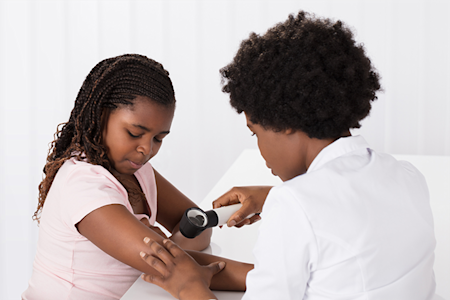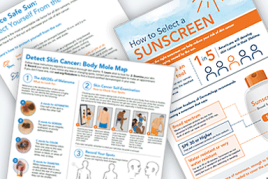Molluscum contagiosum: Diagnosis and treatment
If you have bumps on your skin, the U.S. Food and Drug Administration (FDA) recommends that you see a health care professional like a board-certified dermatologist
The FDA cautions, “You might do more harm than good” if you try to diagnose or treat yourself.

How do dermatologists diagnose molluscum contagiosum?
A board-certified dermatologist can often diagnose this condition by looking at the bumps on your skin. For most patients, that’s all that’s required.
Occasionally, your dermatologist will need more information and will scrape off a bit of the infected skin so that it can be examined under a microscope. Your dermatologist can scrape off what’s needed during your office visit.
Molluscum contagiosum doesn’t always require treatment
If you have molluscum, your dermatologist may recommend letting this condition clear on its own rather than treating it. When you have a healthy immune system, the body will get rid of the virus that causes molluscum. Once this happens, the skin will clear. While rare, you may see a tiny depressed scar.
Clearing can take time. For many children, the body clears the infection within 6 to 9 months. Sometimes, it takes longer.
When do dermatologists recommend treating molluscum contagiosum?
Treatment may be recommended for patients who have:
A chronic skin condition, such as eczema
Molluscum in the genital area
A weakened immune system and numerous bumps
Extremely bothersome molluscum
HIV infection: Treatment recommended
If you have an HIV infection and molluscum, the bumps can be big and cover a large area of skin. Starting antiretroviral therapy (ART) can help clear your skin of molluscum. In fact, ART is considered the treatment of choice for anyone who is living with HIV and has molluscum.
Use a non-prescription product to treat molluscum only when recommended by your dermatologist
You’ll find products that you can buy without a prescription to treat molluscum
To avoid products that don’t work and to prevent possible side effects, use a non-prescription product only when recommended by your dermatologist.

The U.S. Food and Drug Administration (FDA) says companies are selling non-prescription products to treat molluscum that:
Are unlikely to do what they claim
May contain ingredients that can cause side effects (bad reactions)
The FDA has received reports of children and adults developing side effects after using these products. Reported side effects include skin reddening, abrasions (skin rubbing or wearing away) from people scratching their skin, and permanent scarring.
According to the FDA, many of these products contain essential oils. While these ingredients may sound safe, the FDA cautions, “Even essential oils may cause an allergic reaction or irritate sensitive skin.”
Watch out for misleading claims on non-prescription products
Some of the companies selling these non-prescription products include a misleading statement on their products that suggests the FDA has endorsed or approved the product.
The FDA says that you may see one of the following misleading claims on these non-prescription products:
FDA approved
FDA registered
Made in an FDA-registered facility
Complies with FDA Current Good Manufacturing Practices (or CGMPs)
If you see one of these statements on a product that you can buy without a prescription to treat molluscum, you know the statement is false. When it comes to treating molluscum, the FDA has only approved medications that require a prescription.
While only prescription medications have FDA approval, you don’t need to discount non-prescription treatments completely. For some children and adults, this type of treatment can be effective. Your dermatologist knows which non-prescription treatments can be safe and effective and who can benefit from them.
How do dermatologists treat molluscum contagiosum?
Dermatologists choose treatment based on many considerations, such as a patient’s overall health, number of molluscum bumps, and where the bumps appear. For children, age is also an important consideration.
If treatment is recommended, your dermatologist may recommend treatment that you:
Receive in your dermatologist’s office.
Apply at home.
Take for a prescribed amount of time.
No matter which treatment is used, it takes time to clear molluscum contagiosum. The following explains the different treatments and what each involves.
Treatment you receive in a dermatologist’s office
The goal of an in-office treatment is to destroy the bumps without harming the skin. To do this, your dermatologist may use:
Cantharidin (beetle juice): This treatment is FDA approved to treat adults and children 2 years of age and older. It’s often called “beetle juice” because cantharidin is a substance that many male blister beetles secrete.
Dermatologists have been using cantharidin to treat warts and molluscum since the 1950s. When treating molluscum bumps, your dermatologist carefully places some beetle juice on each bump, applying it in such a way that a water blister later forms.
You will likely see a blister on each treated bump within 24 to 48 hours. As the skin heals, the bumps clear. This usually occurs within 2 weeks.
To be effective, most patients need at least 2 in-office treatments.
Wash off cantharidin after treatment
When your dermatologist uses cantharidin (beetle juice) to treat molluscum, you need to wash it off at home with soap and water, within the time frame that your dermatologist gives you. This helps prevent excessive blistering that could lead to serious skin irritation.

When applied by a dermatologist, cantharidin is a safe and effective treatment for molluscum. It’s often used to treat young children because it is painless when applied.
Brand name: Ycanth
Warning: Cantharidin should only be applied in a doctor’s office
If you buy this treatment online and apply it at home, you risk serious side effects, such as deep chemical burns, intense pain, and permanent scarring.
Cryosurgery: Seeing “surgery” in the name of this treatment may have you wondering if your dermatologist will cut into the skin. No cutting is involved. This treatment is a procedure that your dermatologist can perform during an office visit.
To perform cryosurgery, your dermatologist applies an extremely cold substance like liquid nitrogen to each molluscum bump. This extreme cold can effectively destroy the bumps. You will need to return for treatment every 2 to 3 weeks until the bumps clear.
Cryosurgery can be painful, so it’s not always recommended for young children. Due to the pain, it’s seldom used to treat patients who have many molluscum bumps.
Curettage: During this treatment, your dermatologist uses a medical device called a curette to remove the molluscum bumps from the skin. In skilled hands, this is an effective treatment that causes little or no bleeding.
Because your dermatologist cuts into the skin, this treatment can be frightening for young children. As such, curettage is usually only performed on older children, teens, and adults.
Pulsed dye laser (PDL): This may be a treatment option for someone who has many molluscum bumps. It’s also recommended for patients with difficult-to-treat molluscum, including those who are immunosuppressed.
Studies show that a PDL can effectively treat dozens of bumps. During one such study, 43 patients who had many molluscum bumps were treated with the PDL. In 42 of these patients, all the bumps cleared within one month of PDL treatment.
If used on the face, the treated skin tends to heal completely in 1 to 2 weeks. When treating other areas of the body, the skin tends to heal completely in 2 to 4 weeks.
If you are considering PDL, it’s important to know the following:
Insurance rarely covers the cost of this treatment, which tends to be expensive.
PDL has been safely and effectively used on children as young as 8 years old, but it may be difficult to treat younger children with PDL.
People who have darker skin tones can develop temporary (often lasting 6 weeks to 6 months) lighter or darker spots on the skin treated with the PDL.
Not every dermatology office offers PDL, so you may be referred to another dermatologist for treatment.
Use forceps or a scalpel to remove the core: During this procedure, your dermatologist squeezes each molluscum bump to remove the cheesy substance inside, which contains the virus. This can be painful, so medication is first applied to numb your skin.
You should not try this at home. Without proper technique, you can cause a serious infection and spread the virus to other parts of your body.
Treatment you apply at home
Sometimes, molluscum is best treated with a medication that you apply at home. While you will find many treatments sold online, it’s important to see a dermatologist first. Doing so helps provide you with the most effective treatment and reduce possible side effects like lingering dark spots and scars.
Medications that patients apply at home include:
Berdazimer gel: This prescription medication works to clear or reduce the bumps. It’s FDA approved to treat patients 1 year or older who have molluscum contagiosum.
If prescribed, you will receive 2 tubes. One tube contains berdazimer gel. The other tube contains hydrogel.
Before applying this medication to the skin, you mix equal amounts from each tube. Then you evenly apply a thin layer to the molluscum bumps. Avoid applying it to the skin without molluscum. When you finish, wash your hands thoroughly to avoid getting the medication in areas like your eyes.
You will continue to mix and apply this preparation once a day for up to 12 weeks.
Possible side effects include pain (such as burning or a stinging sensation), and redness (lighter skin tones), or slight skin discoloration (darker skin tones).
Brand name: Zelsuvmi
Imiquimod cream: This prescription medication helps stimulate the body’s immune system so that it will clear the bumps.
You apply the cream as directed to the bumps, usually 2 or 3 times a week. After the cream sits on the bumps for a prescribed amount of time, you wash it off. Many patients choose to apply imiquimod at night before bed and wash it off in the morning.
You must continue to apply imiquimod until the bumps clear, which is usually about 16 weeks.
It’s important to know that no one treatment works for everyone. Signs that imiquimod is activating the immune system include swelling and irritated skin.
The U.S. Centers for Disease Control and Prevention (CDC) does not recommend imiquimod for children. Some studies show that this medication doesn't work well for children who have molluscum contagiosum.
Brand names: Aldara, Zyclara
Salicylic acid: Often used to treat warts, this can be effective for molluscum as well. Your dermatologist can tell you how often to apply it. The goal is to continue using it until you get a reaction.
While this is a non-prescription treatment, you should only use salicylic acid if your dermatologist recommends it. No treatment is right for everyone.
Tretinoin: To get results, you must apply this prescription medication correctly. Your dermatologist can show you how to apply it by using a toothpick or fine-tipped applicator to get the reaction you need. The goal is to irritate the surface of the skin, which can help the body’s immune system clear the virus.
Brand names: Altinac, Atralin, Avita, Renova, Retin-A, Tretin-X
Medication you take at home
Cimetidine: This medication is used to treat ulcers and conditions that cause the stomach to produce too much acid, such as heartburn.
It may also be a treatment option for a patient who has severe eczema (atopic dermatitis) and molluscum that covers most of the body. Dermatologists recommend it only when other treatments fail to work.
While this is a non-prescription treatment, you should only use it if your dermatologist recommends it. No treatment is right for everyone.
What is the outcome for someone who has molluscum contagiosum?
For most people, the skin will clear without treatment, usually within 18 months. A few people continue to have bumps for longer.
Treating molluscum may clear the skin more quickly; however, the bumps can return after treatment. It’s also possible to pick up the virus again, which can cause new bumps.
Following the self-care that dermatologists recommend can help prevent new bumps. You’ll find these recommendations at, Molluscum contagiosum: Self-care.
Images
Getty Images
References
Brunk D. “Managing molluscum contagiosum: The great imitator.” Pediatr News. December 3, 2014.
Centers for Disease Control and Prevention (CDC):
“ About molluscum contagiosum.” Page last reviewed May 2024. Page last accessed January 30, 2025.
Coloe, J. “P3004: Evaluation of the efficacy and safety of cantharidin 0.7% in the treatment of pediatric molluscum contagiosum.” J Am Acad Dermatol. 2009;60(3): Suppl. 1, Page AB143. No financial disclosure identified.
Dohil MA, Lin P, et al. “The epidemiology of molluscum contagiosum in children.” J Am Acad Dermatol. 2006;54(1):47-54.
Guzman AK, Schairer DO, et al. “Safety and efficacy of topical cantharidin for the treatment of pediatric molluscum contagiosum: a prospective, randomized, double-blind, placebo-controlled pilot trial.” Int J Dermatol. 2018;57(8):1001-6.
Jahnke MN, Hwang S, et al. “Cantharidin for treatment of facial molluscum contagiosum: A retrospective review.” J Am Acad Dermatol. 2018;78(1):198-200.
Leung AKC, Barankin B, et al. “Molluscum contagiosum: An update.” Recent Pat Inflamm Allergy Drug Discov. 2017;11(1):22-31.
Pavlovic M. “Treatment of facial molluscum contagiosum with trichloroacetic acid.” Pediatr Dermatol. 2009 Jul-Aug; 26(4):425-6.
Schaffer JV, Berger EM. “Molluscum contagiosum.” JAMA Dermatology Patient Page. September 2016. Last accessed March 25, 2019.
Skinner RB, Jr. “Treatment of molluscum contagiosum with imiquimod 5% cream.” J Am Acad Dermatol 2002;47:S221-4.
Tom W, Fallon Friedlander S. “Poxvirus infections.” In: Wolff K, Goldsmith LA, et al. Fitzpatrick’s Dermatology in General Medicine (seventh edition). McGraw Hill Medical, New York, 2008: 1911-13.
U.S. Food and Drug Administration:
“FDA approves first treatment for molluscum.” Last updated 7/24/2023. Last accessed 8/24/2023.
“Safely treating molluscum, a common skin condition.” Last updated 8/23/2023. Last accessed 8/24/2023.
Berdazimer topical gel (package insert). (Revised 1/2024). Last accessed 1/31/ 2025.
van der Wouden JC, van der Sande R, et al. “Cochrane Review: Interventions for cutaneous molluscum contagiosum.” Cochrane Database Syst Rev. 2017;5:CD004767.
Written by:
Paula Ludmann, MS
Reviewed by:
Elaine T. Kaye, MD, FAAD
Elan Newman, MD, FAAD
Brittany Oliver, MD, FAAD
Last updated: 3/10/25
 Atopic dermatitis: More FDA-approved treatments
Atopic dermatitis: More FDA-approved treatments
 Biosimilars: 14 FAQs
Biosimilars: 14 FAQs
 How to trim your nails
How to trim your nails
 Relieve uncontrollably itchy skin
Relieve uncontrollably itchy skin
 Fade dark spots
Fade dark spots
 Untreatable razor bumps or acne?
Untreatable razor bumps or acne?
 Tattoo removal
Tattoo removal
 Scar treatment
Scar treatment
 Free materials to help raise skin cancer awareness
Free materials to help raise skin cancer awareness
 Dermatologist-approved lesson plans, activities you can use
Dermatologist-approved lesson plans, activities you can use
 Find a Dermatologist
Find a Dermatologist
 What is a dermatologist?
What is a dermatologist?